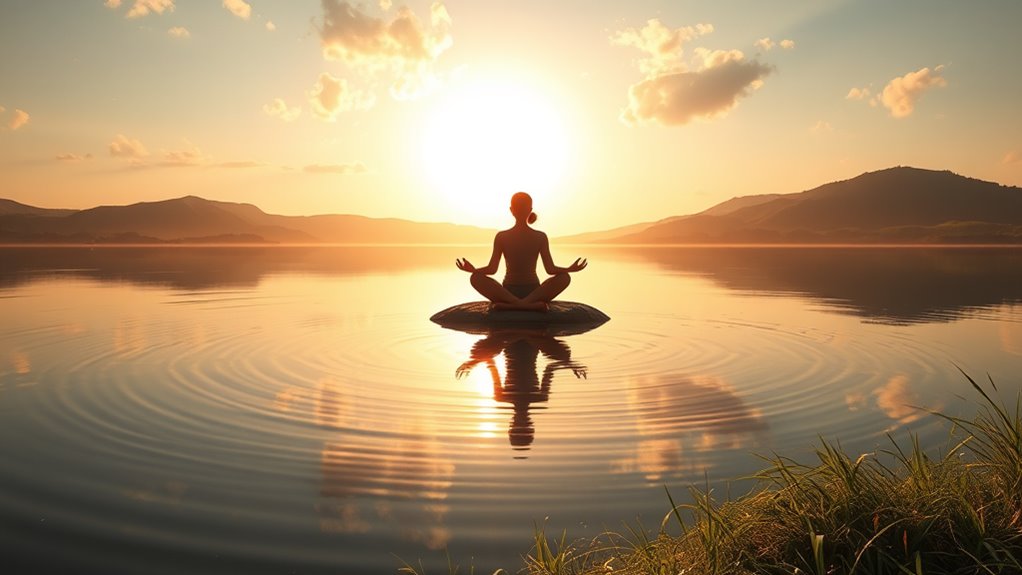Find Focus in Chaos With These Visualization Exercises!
When chaos surrounds you, visualization exercises can be your lifeline. Start by finding a quiet space, close your eyes, and breathe deeply. Picture your goals and imagine each detail vividly, allowing your subconscious to guide you toward clarity. Try incorporating color visualization to evoke calm or motivation. Use techniques like the 5-4-3-2-1 grounding method to anchor yourself. Consistent practice can empower your focus and resilience in turbulent moments. You’ll discover even more techniques to elevate your practice!
Key Takeaways
- Engage in deep breathing exercises to center your mind, helping you focus amidst chaos before starting your visualization practice.
- Visualize a peaceful environment in vivid detail, engaging all your senses to create calmness in stressful situations.
- Use color visualization to evoke emotions: imagine blue for calmness or green for harmony to enhance focus when overwhelmed.
- Incorporate a daily visualization routine, setting clear intentions to guide your focus and establish a sense of control over chaos.
- Recall calming imagery during stressful moments to steady your thoughts and redirect your focus towards productive actions.
Understanding Visualization and Its Benefits
While you may not realize it, visualization is a powerful tool that can enhance your understanding and performance in various aspects of life. Often dismissed as mere daydreaming, visualization allows you to mentally rehearse scenarios, improving your focus and clarity.
By engaging in focus exercises, you refine your ability to concentrate on vital tasks amidst distractions. Imagine yourself executing a skill perfectly or achieving a goal; this mental practice lays the groundwork for real-world success.
It’s about making the subconscious a reliable ally, helping you embrace challenges more effectively. When you incorporate visualization into your routine, you’re not just imagining possibilities—you’re setting yourself up for mastery. Additionally, engaging in effective visualization techniques can lead to increased mental resilience and productivity.
Embrace it and watch how your performance transforms, releasing untapped potential.
The Power of Mental Imagery
When you harness the power of mental imagery, you create a vivid blueprint for success in your mind. This technique allows you to visualize your goals, transforming abstract desires into tangible results.
By consistently imagining every detail of your desired outcome, you engage your subconscious, paving the way for focused action. Picture yourself achieving your objectives: the emotions, environment, and sensations become real in your mind, solidifying your intentions.
This process not only boosts confidence but also enhances performance in high-pressure situations. As you master the art of mental imagery, you’ll find that your mind becomes a powerful ally, guiding you effortlessly toward your aspirations.
Additionally, by employing creative visualization techniques, you can further amplify the effectiveness of your mental imagery practice, turning your dreams into realizable goals.
Breathing and Visualization Techniques
Breathing plays an essential role in enhancing your visualization techniques, as it helps center your mind and body.
Start by finding a quiet space where you can fully focus. Inhale deeply through your nose, allowing your abdomen to expand. Hold that breath for a moment, then exhale slowly through your mouth.
As you breathe, visualize each inhalation as energy filling your body, and each exhalation as stress leaving. With each breath, picture your goals manifesting clearly in your mind—see the details vividly. This practice aligns with effective visualization techniques, which can significantly enhance your concentration and mental clarity.
This practice not only sharpens your focus but also calms racing thoughts. By mastering your breathing alongside visualization, you’ll strengthen your ability to manifest your desired outcomes with precision and clarity.
Guided Imagery for Stress Relief
Visualization techniques can be taken a step further with guided imagery, especially for relieving stress. When you engage in this practice, you’re immersing yourself in vivid mental scenarios that promote relaxation.
Start by finding a quiet space, closing your eyes, and letting your mind drift to a tranquil environment—perhaps a serene beach or a lush forest.
Picture every detail: the sounds, smells, and textures around you. Allow the soothing sensations to wash over you, dissipating tension with each breath. You’re not just visualizing; you’re actively experiencing the calmness of your imagined sanctuary. This practice is particularly effective because it helps to calm your mind, enabling you to achieve a more restful state before sleep.
Visualizing Success: Setting Goals
Success often starts in the mind, and visualizing your goals can be a transformative practice. By creating a vivid mental image of your desired outcomes, you enhance motivation and clarify your path. Try using the following table to structure your visualizations:
| Goal | Visualization Technique | Milestone |
|---|---|---|
| Career Advancement | Picture your future office | Land a promotion |
| Health Improvement | Imagine your fit self | Run a 5K |
| Financial Success | See your bank balance grow | Save a specific amount |
| Skill Mastery | Visualize practicing daily | Achieve a certification |
| Personal Growth | Envision overcoming obstacles | Cultivate resilience |
Focus on each goal, reinforce your vision daily, and watch your aspirations materialize. Incorporating mindfulness practices into your visualization can further enhance your ability to stay committed to your goals.
Nature Visualization for Calmness
Bringing your goals to life isn’t just about ambition; it’s also about cultivating a sense of calm to help you stay focused.
Nature visualization can play a crucial role in achieving this serenity. Here’s how you can integrate it into your routine:
-
Choose a setting: Picture a tranquil forest or a serene beach—any place in nature that brings you peace.
-
Engage your senses: Imagine the sounds, scents, and sensations of your chosen environment, allowing yourself to feel immersed.
-
Breathe deeply: As you visualize, synchronize your breath with the rhythm of nature, inhaling calmness and exhaling stress.
-
Reflect on your intentions: Let the clarity of nature sharpen your focus on your goals, reinforcing your commitment to them.
Harness this exercise to promote inner peace and sharpen your vision.
Color Visualization for Emotional Balance
Color can greatly affect your emotions, and using color visualization can help you find balance.
By understanding color psychology, you can identify which hues resonate with your feelings and promote emotional release.
Let’s explore some effective techniques that tap into the power of color for your emotional well-being.
Harnessing Color Psychology
When you tap into the principles of color psychology, you can effectively influence your emotional state and find balance in your daily life.
By consciously incorporating specific colors, you can enhance your mood and cultivate the feelings you desire.
Here are four key colors to contemplate:
-
Blue – Promotes calmness and reduces stress.
-
Yellow – Sparks creativity and uplifts your spirits.
-
Green – Inspires harmony and revitalizes energy.
-
Red – Boosts motivation and stimulates passion.
Techniques for Emotional Release
Release the power of visualization to release emotional tension and restore balance in your life. Picture vibrant colors embodying various emotions. As you inhale, visualize calming blue to soothe anxiety. With each exhale, imagine releasing toxic energy as a dull gray. This simple practice fosters emotional clarity and resilience.
| Emotion | Color |
|---|---|
| Anxiety | Blue |
| Anger | Red |
| Joy | Yellow |
Practice regularly; your mind craves this mastery. Integrating color visualization promotes emotional intelligence, allowing awareness of your sentiments. This technique not only clears emotional blockages but also enhances your overall well-being. Commit to this exercise, and witness the transformation in how you navigate emotional landscapes.
The 5-4-3-2-1 Grounding Technique
The 5-4-3-2-1 Grounding Technique is a powerful way to boost your sensory awareness and bring yourself back to the present moment.
By following simple step-by-step instructions, you can effectively calm your mind and reduce anxiety.
Let’s explore how this technique can benefit you in everyday life.
Sensory Awareness Activation
As you navigate moments of stress or anxiety, engaging your senses through the 5-4-3-2-1 grounding technique can be incredibly effective.
This approach allows you to anchor yourself in the present moment by heightening your sensory awareness.
To activate your senses, identify and focus on:
- Five things you can see – observe colors, shapes, or patterns around you.
- Four things you can touch – feel textures, temperature, or the weight of objects nearby.
- Three things you can hear – listen to background noises or the sound of your breath.
- Two things you can smell – notice scents in the air or on your skin.
Step-by-Step Instructions
To effectively use the 5-4-3-2-1 grounding technique, follow these simple steps to bring your awareness back to the present.
Start by identifying five things you can see around you. Notice their colors, shapes, and details.
Next, move to four things you can touch; feel their textures and temperatures.
Then, listen for three distinct sounds in your environment. Focus on each sound’s frequency and volume.
After that, acknowledge two scents you can identify; breathe them in deeply.
Finally, take a moment to taste something—be it the remnants of a meal or your own breath.
As you follow these steps, commit to being fully present, allowing each sensory experience to anchor you in the moment.
Benefits of Grounding Technique
While you mightn’t realize it, practicing the 5-4-3-2-1 grounding technique offers numerous mental health benefits. This powerful exercise helps you regain control, centering your thoughts amidst chaos.
Here are four key advantages:
-
Reduces Anxiety: By focusing on your surroundings, you can diminish overwhelming feelings.
-
Enhances Presence: It anchors you in the moment, improving mindfulness.
-
Boosts Emotional Regulation: You learn to manage your emotional responses effectively.
-
Increases Focus: Redirecting your attention helps eliminate distractions, sharpening your concentration.
Incorporating the 5-4-3-2-1 technique into your routine can greatly improve your mental resilience, empowering you to master challenges with clarity and confidence.
Creating a Personal Visualization Routine
Creating a personal visualization routine can considerably enhance your ability to achieve your goals. Start by carving out time each day—early morning or just before bed works well.
Find a quiet space where you won’t be disturbed, and get comfortable. Close your eyes, take deep breaths, and focus on your ambition. Imagine every detail of achieving it: the sights, sounds, and emotions involved.
Visualize overcoming obstacles with confidence and resilience. Consistency is key, so aim to practice daily. After a week, assess your progress and adjust your imagery as needed.
Stay committed and allow your mind to strengthen your intention. Over time, this focused practice will help align your actions with your aspirations. Embrace the journey toward mastery.
Integrating Visualization Into Daily Life
Integrating visualization into your daily life can enhance both your mornings and your ability to manage stress.
By starting your day with a visualization ritual, you set a positive tone that can carry you through challenges.
Plus, using visualization as a tool for stress relief helps you reclaim your focus and calm your mind in hectic moments.
Morning Visualization Rituals
As you wake up each morning, embracing visualization rituals can set a positive tone for your day, transforming your mindset and intentions.
To elevate your practice, consider incorporating these four powerful techniques:
-
Set Clear Intentions: Visualize what you want to achieve today. Picture yourself accomplishing it with clarity and confidence.
-
Create a Vision Board: Spend a few minutes reviewing images that inspire you, reinforcing your goals through visual stimulation.
-
Practice Gratitude: Visualize three things you’re thankful for, allowing positivity to fill your mindset.
-
Mindful Breathing: Before diving into your day, take slow breaths while visualizing vibrant energy surrounding you, preparing you for success.
Integrating these rituals can transform mundane mornings into powerful beginnings.
Visualization for Stress Relief
Visualizing your goals can set a productive tone for the day, but it also offers a powerful tool for managing stress.
To integrate visualization into your daily life, take a few minutes each day to imagine yourself in a peaceful, calming environment—perhaps a serene beach or a tranquil forest.
Focus on the details: the sounds, colors, and scents. Picture your worries dissolving as you breathe deeply. This practice not only redirects your mind but also activates your body’s relaxation response.
When stress arises, recall this imagery to regain composure. By regularly visualizing calm and clarity, you build resilience against daily pressures, ensuring you stay centered and poised amidst life’s chaos.
Embrace this mastery, and watch your stress diminish.
Frequently Asked Questions
How Long Should I Practice Visualization Each Day?
When you paint your mind’s canvas, aim for ten to twenty minutes daily. Consistency is key. As you deepen your practice, you’ll sharpen your focus, revealing new levels of clarity and mastery in your life.
Can Visualization Help With Anxiety and Panic Attacks?
Yes, visualization can greatly help with anxiety and panic attacks. By creating mental images of calm, safe places, you anchor yourself, shifting your focus away from distressing thoughts, and promoting relaxation and control over your emotions.
What Environments Are Best for Visualization Exercises?
Certain environments can enhance your visualization practice. Quiet spaces, nature settings, or cozy nooks help you connect deeply. Eliminate distractions, breathe slowly, and embrace the serene surroundings to foster clarity and focus during your exercises.
Is There Science Supporting Visualization Effectiveness?
Yes, research shows visualization enhances performance and motivation. You’re engaging your brain’s neural pathways, which can create lasting change. By consistently practicing, you’ll harness this power, improving your focus and achieving your goals more effectively.
Can Visualization Improve Performance in Sports or Activities?
Studies show athletes using visualization can improve performance by up to 45%. You’ll harness this mental tool to refine your skills, build confidence, and gain a competitive edge, transforming your approach and enhancing your mastery in any sport.





